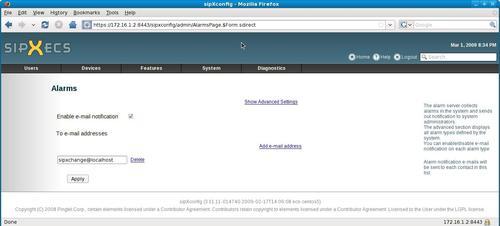sipXecs has an elaborate alarm server running on the system. The alarm server collects alarms in the system and sends out email notifications to system administrators. The alarm settings can be accessed via the Alarms menu item in the Diagnostics menu. The following screenshot shows the initial alarm screen:

Any number of email addresses can be entered to receive system alarms.
Clicking on the Show Advanced Settings hyperlink will allow the system administrator to specify the sending email address and enable or disable notifications for the following system alarms:
1. Emergency number dialed: Email alert of a user dialing an emergency number
2. Login failed: Failed attempt to login to PBX
3. Emergency number dialed
4. Login failed
5. Stray packets were detected by the Media Relay service
6. Failed to initialize the Media Relay
7. SipXproxy lost contact with the Media Relay
8. SipXproxy re-established connection with the Media Relay
9. SipXproxy detected a Media Relay reset but recovered...



